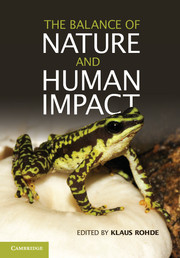Book contents
- Frontmatter
- Contents
- Foreword
- List of contributors
- Acknowledgments
- Introduction
- Part I Nonequilibrium and Equilibrium in Populations and Metapopulations
- Part II Nonequilibrium and Equilibrium in Communities
- Part III Equilibrium and Nonequilibrium on Geographical Scales
- Part IV Latitudinal Gradients
- Part V Effects Due to Invading Species, Habitat Loss and Climate Change
- 13 The physics of climate: equilibrium, disequilibrium and chaos
- 14 Episodic processes, invasion and faunal mosaics in evolutionary and ecological time
- 15 The emerging infectious diseases crisis and pathogen pollution
- 16 Establishment or vanishing: fate of an invasive species based on mathematical models
- 17 Anthropogenic footprints on biodiversity
- 18 Worldwide decline and extinction of amphibians
- 19 Climatic change and reptiles
- 20 Equilibrium and nonequilibrium in Australian bird communities – the impact of natural and anthropogenic effects
- 21 Population dynamics of insects: impacts of a changing climate
- 22 The futures of coral reefs
- Part VI Autecological Studies
- Part VII An Overall View
- Index
- References
22 - The futures of coral reefs
from Part V - Effects Due to Invading Species, Habitat Loss and Climate Change
Published online by Cambridge University Press: 05 March 2013
- Frontmatter
- Contents
- Foreword
- List of contributors
- Acknowledgments
- Introduction
- Part I Nonequilibrium and Equilibrium in Populations and Metapopulations
- Part II Nonequilibrium and Equilibrium in Communities
- Part III Equilibrium and Nonequilibrium on Geographical Scales
- Part IV Latitudinal Gradients
- Part V Effects Due to Invading Species, Habitat Loss and Climate Change
- 13 The physics of climate: equilibrium, disequilibrium and chaos
- 14 Episodic processes, invasion and faunal mosaics in evolutionary and ecological time
- 15 The emerging infectious diseases crisis and pathogen pollution
- 16 Establishment or vanishing: fate of an invasive species based on mathematical models
- 17 Anthropogenic footprints on biodiversity
- 18 Worldwide decline and extinction of amphibians
- 19 Climatic change and reptiles
- 20 Equilibrium and nonequilibrium in Australian bird communities – the impact of natural and anthropogenic effects
- 21 Population dynamics of insects: impacts of a changing climate
- 22 The futures of coral reefs
- Part VI Autecological Studies
- Part VII An Overall View
- Index
- References
Summary
Coral reefs are severely threatened and their future looks dire
Coral reefs, as we knew them in the 1970s, are likely to have disappeared entirely from the planet by 2050, if current trends in human environmental impacts continue. This claim is predicated principally on continued growth in atmospheric concentrations of greenhouse gases and continued ocean acidification (Hoegh-Guldberg et al., 2007; Veron et al., 2009; Sale, 2011). Indeed, late in 2011, it is difficult to see how we will mobilize quickly enough to alter our behavior sufficiently, in time to save them, although several authors now point to the spatial heterogeneity with which reefs are degrading, and suggest that in some regions reefs may survive through 2100 (Hughes et al., 2010; Anthony et al., 2011; Edwards et al., 2011; Hoeke et al., 2011). I believe the chance of such survival is vanishingly small. What will be left is eroding limestone benches, dominated by macroalgae, and with small, isolated coral colonies. In this chapter, I discuss the various possible futures for coral reefs, and the reasons for my dire prediction. Reef ecosystems suffer because their keystone species are proving particularly susceptible to certain of our environmental impacts. The fact that they could disappear within 40 years is testament to the limited capacity for homeostasis among natural ecosystems and to the capacity of humanity to alter fundamental properties of the planetary environment.
Coral reefs: fragile, transitory ecosystems of the ocean-atmosphere boundary zone
Humans have been damaging coral reef ecosystems around the world almost since humans and reefs first came into contact. There are several reasons for this (Sale, 2008). They all concern the particular dependence of the reef ecosystem on the survival and health of one group of ecologically delicate species, the corals themselves. Coral reefs are one of the few ecosystems in which major components of the physical structure of the system are produced by the organisms themselves (rainforests are approximate analogs). On reefs, the rocky structure with its complex topography is the result of calcification by a broad range of organisms but including in particular the corals themselves.
- Type
- Chapter
- Information
- The Balance of Nature and Human Impact , pp. 325 - 334Publisher: Cambridge University PressPrint publication year: 2013
References
- 1
- Cited by



